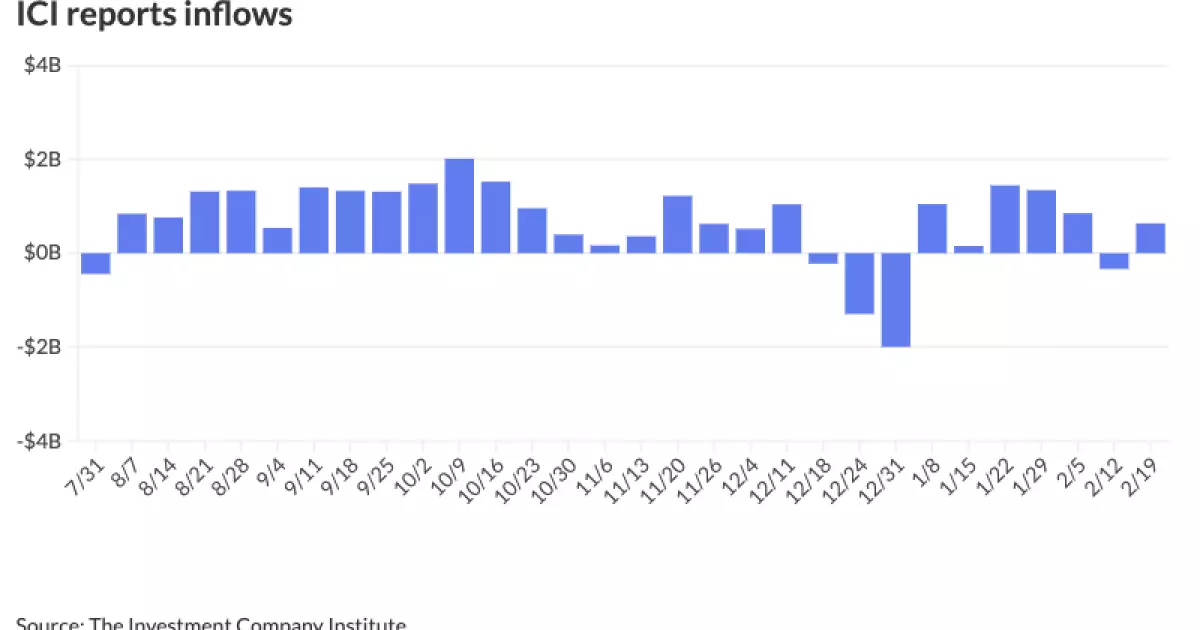The municipal bond market recently exhibited signs of stability amidst fluctuating U.S. Treasury yields and mixed equity performance. On a Wednesday marked by shifting financial tides, municipal securities showed a slight uptick in value. Key statistics highlighted the ongoing relationship between municipal bonds and U.S. Treasury (UST) yields. For instance, the two-year ratio stood at 63%, while longer-term maturities such as the 30-year boasted a ratio of 87%. This suggests that while there is firming in certain sectors, overall investor sentiment may still be cautious as they navigate through potentially turbulent economic forecasts.
Recent reports from the Investment Company Institute (ICI) indicated a notable turnaround in inflows, with the market experiencing a net gain of $635 million for the week ending February 19. This follows a week of significant outflows, suggesting a volatile but ultimately resilient market environment. In particular, exchange-traded funds (ETFs) witnessed substantial inflows totaling $782 million, contrasting sharply with previous weeks. Such movements typically reflect investors’ anticipation of future economic conditions and a desire to capitalize on favorable yields before potential changes in tax policy.
This year has begun with a “heavy start” in issuance, as analysts from the municipal sector indicate an influx of capital seeking opportunities in the municipal bond market. Driven by factors such as the looming threat of tax exemption changes and the urgent need for infrastructure improvements, municipalities are eager to issue bonds to secure financing before any potential policy shifts occur. Jeff Devine, a municipal research analyst, highlights that inflation, coupled with rising construction costs, has prompted municipalities to accelerate their borrowing strategies to fund essential projects.
Mega deals have become a prominent feature of the current issuance climate. Deals such as the recent $1 billion offering from the South Carolina Public Service Authority illustrate this trend. February, often viewed as a stabilizing month, contrasts with the anticipated drop in coupons and maturities expected in the following months—March and April. This drop can lead to speculative dynamics as investors reassess their strategies in light of market changes, potentially affecting demand and pricing models.
A significant topic of discussion in the municipal finance arena is the potential elimination or modification of the tax exemption status for municipal bonds. Such a policy change could have far-reaching implications, increasing borrowing costs for municipalities and necessitating alternative revenue generation methods. This, in turn, could lead to higher taxes for local communities, ultimately affecting consumption patterns and economic stability on a state-by-state basis.
Despite these concerns, some analysts remain optimistic about the long-term preservation of the tax exemption. They argue that while discussions surrounding it are frequent in budget negotiations, the actual likelihood of its removal remains relatively low. Historical contexts, such as the phase-out of advanced refunding provisions in 2017, provide evidence that while lawmakers often consider taxing these instruments, drastic measures often fail to materialize.
Recent discussions have also highlighted an emerging bipartisan willingness to explore alternatives to support the municipal market, including proposals for using the “scoring method” preferred by Senate Republicans. If successful, such measures might secure the tax exemption for municipal bonds without the extensive offsets typically required in reconciliations. However, there’s a caveat, as certain sectors, like higher education, appear increasingly vulnerable to potential marginalization regarding tax exemptions.
Recent activity in the primary municipal market indicates robust demand amidst the aforementioned uncertainties. For example, BofA Securities successfully priced substantial offerings for entities like the New York City Municipal Water Finance Authority and Auburn University. These transactions demonstrate continued investor appetite for municipals, driven partly by competitive yields in comparison to other asset classes.
In the broader context, even amid economic fluctuations, the municipal market displays resilience. Upcoming issuances, including projects from the Black Belt Energy Gas District and the Pennsylvania Turnpike Commission, further amplify this momentum. As municipalities continue to leverage the bond market for critical infrastructure projects, the anticipation surrounding these issues will likely attract investor interest, emphasizing the essential nature of municipal bonds in broader economic stability.
The municipal bond market appears poised for cautious growth amid a dynamic economic landscape. With significant issuance activity and investor commitment evidenced through recent inflows, the inherent resilience of this sector shines through despite uncertain tax policy discussions and rising inflation. As state and local governments adapt to ongoing challenges, the role of municipal bonds in funding public projects and economic development will undoubtedly remain pivotal. Investors and analysts alike will keenly observe developments, navigating their strategies to capitalize on the opportunities facing this vital sector in the financial markets.


Leave a Reply